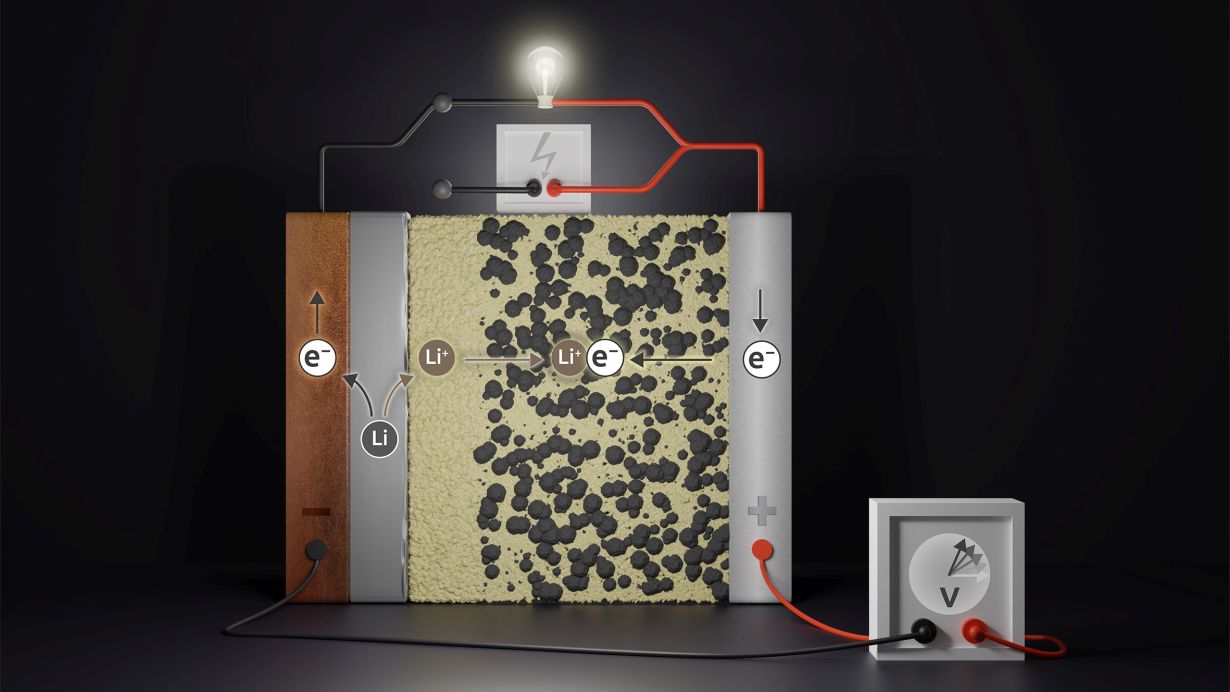Increased safety, bigger storage capacities, shorter charging times – solid-state batteries are to surpass conventional lithium-ion batteries in almost every performance parameter. The battery competence cluster “FestBatt”, with participation of KIT researchers, has established the basics for this technology and is now developing entire battery systems and production methods in a second funding phase. It is funded by the Federal Ministry of Education and Research (BMBF) with around 23 million euros.
In just a few years, the new technology improving on existing lithium-ion batteries could give electric mobility a decisive push. Professor Helmut Ehrenberg of KIT’s Institute for Applied Materials (IAM), coordinator of the characterization platform in the competence cluster “FestBatt”, is convinced of this: “Solid-state batteries function without flammable liquid electrolytes and provide higher energy density and shorter charging times. Additionally, toxic and rare materials like cobalt are not required anymore.” The competence cluster “FestBatt”, which started in 2018, develops this key technology on behalf of the Federal Government and it now enters its second funding phase. There is strong international competition – in order to open up future markets for Europe, the Federal Government pooled the competences of 17 scientific institutions into “FestBatt”, which includes universities and Helmholtz institutes as well as institutes of the Fraunhofer Society and the Max Planck Society, all coordinated by the University of Gießen (JLU).
First Steps towards Mass Production
The development of cell components and entire solid-state battery cells based on promising electrolytes will be at the center of the new funding phase. Furthermore, material and process technologies will be developed to aid in their production. However, before a mass production of solid-state batteries can be established, there is a series of scientific and technological challenges that still need to be solved. The characterization platform coordinated by KIT, with participation of the University of Marburg, the Forschungszentrum Jülich, and the JLU, will characterize contact and boundary surfaces using X-ray, synchrotron, and neutron radiation as well as several microscopy techniques on complex multiphase systems. At KIT, one research team will provide the cathode materials coated with special protective layers to partners of the platform and consequently as a reference material to all other projects involved in “FestBatt” for complete characterization.
Leading Edge with Systematic Characterization
In the first funding phase of “FestBatt”, more than 100 researchers worked on transdisciplinary thematic platforms, aiming to identify suitable materials and synthesize different solid electrolytes. The characterization platform systematically studied these materials, discovered the most important factors influencing the synthesis of solid electrolytes, and identified critical changes in composite materials. This now serves as a basis for further development of solid-state batteries during the second phase of “FestBatt”. A reliable determination of the performance characteristics and a classification of the widely different cell concepts that are being developed internationally with high intensity were enabled by developing standardized measurement reports.
Original Publication
Randau, S., Weber, D.A., Kötz, O. et al.: Benchmarking the performance of all-solid-state lithium batteries. Nature Energy, 2020. DOI: https://doi.org/10.1038/s41560-020-0565-1
About FestBatt
The Federal Ministry of Education and Research (BMBF) has been funding the second phase of the BMBF competence cluster for solid-state batteries (FestBatt) since November 2021 with around 23 million euros for a time of three years. In total, FestBatt consists of one accompanying project and nine joint projects that are part of three cell platforms and four cross-section platforms , including the characterization platform coordinated by KIT. FestBatt is closely linked to other BMBF competence clusters (e.g. ProZell and ExcellBattMat). In its second funding phase, the competence cluster is still coordinated by Professor Jürgen Janek of the Center for Materials Research (LaMa) of the University of Gießen.
More Information: https://festbatt.net/
Details on the KIT Energy Center: https://www.energie.kit.edu/index.php
In close partnership with society, KIT develops solutions for urgent challenges – from climate change, energy transition and sustainable use of natural resources to artificial intelligence, sovereignty and an aging population. As The University in the Helmholtz Association, KIT unites scientific excellence from insight to application-driven research under one roof – and is thus in a unique position to drive this transformation. As a University of Excellence, KIT offers its more than 10,000 employees and 22,800 students outstanding opportunities to shape a sustainable and resilient future. KIT – Science for Impact.

